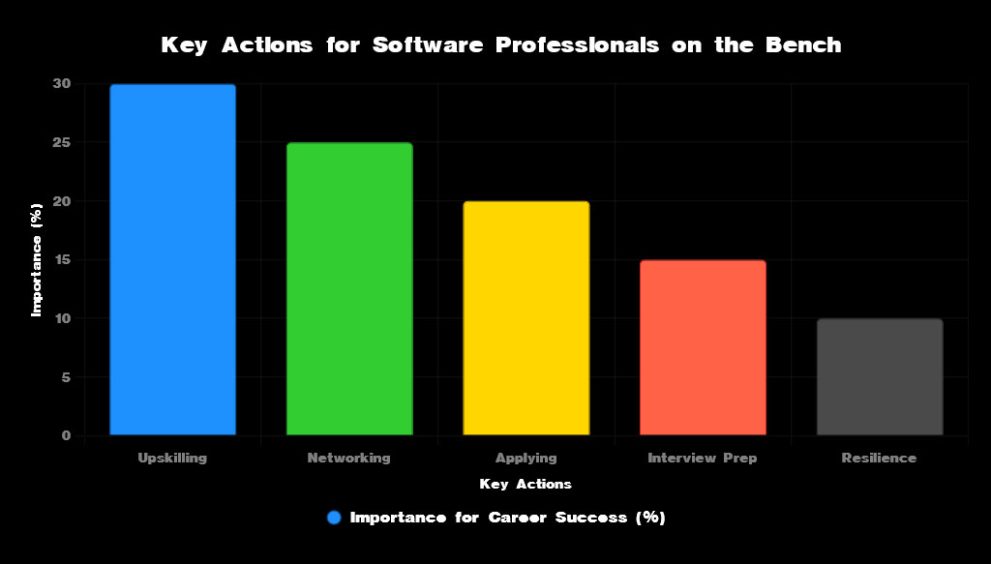Comprehensive Guide for Software Professionals on the Bench or Facing Job Loss

Navigating life on the bench or the uncertainty of job loss in the software industry can feel overwhelming. Yet, these moments are also opportunities to sharpen your skills, expand your network, and pave the way for exciting new projects or roles. This guide offers actionable strategies to thrive on the bench and bounce back stronger if facing termination, empowering you to take control of your tech career.
Part 1: Thriving on the Bench to Secure a Project
Being on the bench—unassigned to a project but still employed—can be a golden window to boost your value within your company. Here’s how to make the most of it:
1. Master Your Company’s Allocation Process
- Learn the System: Understand how your organization assigns projects. Is it through a formal bench management tool, resource allocation teams, or direct manager decisions?
- Engage with Key Players: Schedule one-on-ones with HR or project allocation teams to express your enthusiasm and inquire about upcoming roles.
- Explore Internal Job Boards: Regularly check and apply for open project roles listed on your company’s internal portals.
2. Upskill to Stay Ahead
- Target In-Demand Skills: Identify technologies in demand within your company or industry, such as cloud computing (AWS, Azure), DevOps, AI/ML, or frameworks like React or Spring Boot.
- Leverage Learning Platforms: Enroll in courses on Coursera, Udemy, Pluralsight, or LinkedIn Learning to earn certifications that boost your profile.
- Contribute Internally: Volunteer for internal tools, open-source projects, or hackathons to showcase your skills and stay relevant.
- Join Coding Challenges: Participate in internal or external coding competitions (e.g., LeetCode, HackerRank) to demonstrate your technical prowess.
3. Network Like a Pro
- Build Internal Connections: Connect with project managers, team leads, and peers at company events or informal meetups to stay visible.
- Share Your Expertise: Lead knowledge-sharing sessions, write internal blogs, or give presentations to position yourself as a go-to expert.
- Seek Mentors: Approach senior colleagues for guidance—they may advocate for you when project opportunities arise.
4. Stay Proactive and Adaptable
- Volunteer for Tasks: Offer to assist with documentation, testing, or small tasks on active projects to gain visibility.
- Embrace Flexibility: Be open to new domains or technologies (e.g., a backend developer learning front-end skills) to broaden your appeal.
- Track Your Efforts: Document your contributions, certifications, and networking wins to showcase during manager or HR discussions.
5. Maintain Professionalism
- Stay Positive: Avoid venting frustrations about being on the bench. Instead, project enthusiasm and readiness to contribute.
- Provide Updates: Regularly inform your manager about your learning progress and project readiness to show accountability.
- Follow Policies: Adhere to company guidelines for bench employees, such as attending mandatory training sessions.
6. Prepare for Internal Interviews
- Hone Technical Skills: Practice coding problems on LeetCode or HackerRank and review past projects to ace technical interviews.
- Polish Your Profile: Update your internal resume or profile with your latest skills, certifications, and contributions.
- Ace Behavioral Questions: Prepare for questions about teamwork or challenges using the STAR method (Situation, Task, Action, Result).
Part 2: Navigating Job Loss and Landing a New Role
If you face termination or choose to explore new opportunities, a strategic approach can help you secure a new job swiftly. Here’s your roadmap:
1. Assess Your Situation
- Understand the Cause: Clarify why you were let go (e.g., downsizing, performance, or project completion) to address gaps in future interviews.
- Review Finances: Create a budget to manage expenses during your job search. Consider freelance or part-time gigs for interim income.
- Secure References: If the termination was amicable, request a reference letter or LinkedIn recommendation from your employer.
2. Revamp Your Professional Presence
- Craft a Stellar Resume: Build a concise, results-driven resume with action verbs (e.g., “developed,” “optimized”) and quantifiable achievements (e.g., “reduced load time by 25%”).
- Optimize LinkedIn: Update your profile with a professional photo, compelling headline, and detailed summary. Enable the “Open to Work” feature and list key skills/projects.
- Showcase Your Work: Create a portfolio website or contribute to GitHub to highlight your projects and coding expertise.
3. Upskill to Stay Competitive
- Learn High-Demand Skills: Focus on trending technologies like cloud platforms, full-stack development, or data science. Popular certifications include AWS Certified Solutions Architect or Google Cloud Professional.
- Sharpen Coding Skills: Practice on LeetCode, HackerRank, or Codeforces to nail technical interviews.
- Boost Soft Skills: Enhance communication, teamwork, and problem-solving skills, which are critical for workplace success.
4. Network Strategically
- Tap Your Network: Reach out to former colleagues, classmates, or industry contacts for job referrals. Attend tech meetups, webinars, or conferences.
- Engage Online: Follow companies and tech leaders on LinkedIn and X. Share insights or comment on posts to stay visible.
- Leverage Alumni: Connect with your college or university alumni network for job leads or mentorship opportunities.
5. Apply Smarter, Not Harder
- Target Relevant Roles: Focus on positions that align with your skills and experience. Use job boards like LinkedIn, Indeed, or company career pages.
- Customize Applications: Tailor your resume and cover letter for each role, emphasizing relevant expertise.
- Work with Recruiters: Partner with tech-focused recruitment agencies to access unadvertised opportunities.
- Stay Organized: Track applications, interview dates, and follow-ups using a spreadsheet.
6. Ace Your Interviews
- Technical Prep: Practice coding, system design, and algorithmic questions. Brush up on data structures, algorithms, and design patterns.
- Behavioral Prep: Use the STAR method to answer questions like “Tell me about a time you solved a problem.”
- Mock Interviews: Practice with peers, mentors, or platforms like Pramp or Interviewing.io for real-world simulation.
- Research Companies: Study the company’s products, culture, and recent news to tailor your responses and show genuine interest.
7. Explore Alternative Paths
- Freelancing: Offer your skills on platforms like Upwork or Toptal to gain income and experience during your job search.
- Contract Roles: Consider temporary or contract positions, which may lead to permanent opportunities.
- Startups and Small Firms: Explore roles at startups or smaller companies for flexibility and growth potential.
8. Stay Resilient
- Set a Routine: Treat your job search like a 9-to-5 job, allocating time for applications, networking, and upskilling.
- Seek Support: Lean on friends, family, or career coaches for motivation. Join tech job-seeker communities online.
- Prioritize Well-Being: Stay healthy with exercise, meditation, or hobbies to maintain a positive mindset.
Additional Tips for Success
- Stay Industry-Savvy: Follow tech blogs, podcasts, or X posts from industry leaders to keep up with trends like AI, cloud, or cybersecurity.
- Negotiate Confidently: When offered a role, evaluate salary, benefits, and growth prospects. Don’t shy away from negotiating better terms.
- Learn from Rejections: Request feedback after unsuccessful interviews or project applications to refine your approach.
Conclusion: Turn Challenges into Opportunities
Being on the bench or facing job loss in the software industry is tough, but it’s also a chance to reinvent yourself. On the bench, focus on upskilling, networking, and showcasing your value to secure a project. If seeking a new job, leverage your network, tailor applications, and prepare rigorously for interviews. With resilience and a strategic mindset, you’ll transform these challenges into stepping stones toward a thriving tech career.
Call to Action: Have tips for thriving on the bench or navigating a job search? Share them below, and connect with us on LinkedIn or X for more career insights!












